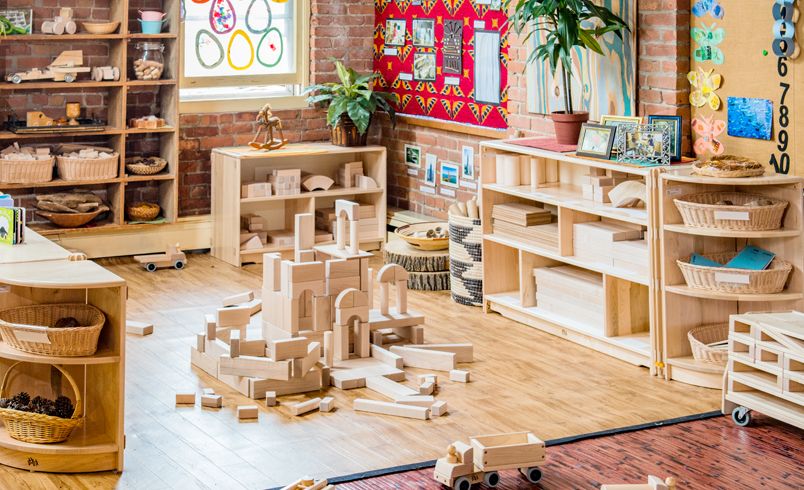.png)
How do we make different play areas visible and interesting?
A classroom should have several different play areas where children can learn, practice, investigate, and, of course, play. It is a good idea to build play areas so that at a glance, you can already see what the point of each one is.
Make the play areas more visible. You can use different types of pictures on the wall and floor. For example, in the car play area, you can use black masking tape on the floor to make roads for the cars, hang pictures of different types of cars and vehicles on the wall, and so on. For animal play, you can use plastic grass on the shelves for animals to walk on, make fences for animals with colorful masking tape on the floor, and again put pictures of different types of animals on the wall near the animal play area.
Toys should be located so that children can easily see and reach them. Toy boxes can be see-through, or if not, the toy boxes should have a picture of the toys that belong in that box. This also makes cleaning the toys much easier - every toy has its own box where it belongs! Cars go to the car box, blocks go to their own box, and so on... When toys are nicely arranged and cared for, children also learn to appreciate the toys and play areas more. It is important that teachers show examples of how to play together with peers and how to clean after playtime is over.
Arranging learning areas by their type
Each learning or play area should be clearly defined by boundaries that separate it from the other areas. The boundary can be anything visible enough for children to understand the limits of the play area, such as low-storage shelves, bulletin boards, tables, chairs, carpets, or even colorful masking tape on the floor.
Similar learning areas should be located close to each other. For example, the library and writing area need quiet space so they can be near each other. On the other hand, the block area and role-play area need more space and allow children to play louder.
Some play areas can be "theme-based" so that they change over time according to the learning theme. For example, if children are learning about farm animals, you could have farm animal play in the classroom, enhanced with pictures, related books, and other little props.
Types of different play areas
-
Block Center
A block area that houses a full set of wooden unit blocks arranged by size and shape in low open shelving that clearly demarcates where each block should be stored
-
Math/Manipulative Center
A math/manipulative area that offers a variety of materials, including puzzles, small blocks, Legos, games, tiles, geoboards, attribute blocks, and other hands-on materials that foster children’s thinking and problem-solving skills and support the development of math (counting, operations, numbers, measurement, geometry)
-
Library/Reading area
A library area should contain a variety of books arranged by area of interest and difficulty level. The types of books should reflect the little readers who learn in the classroom.
-
Writing area
A writing/drawing area that provides different types of paper, crayons/markers/pencils, and maybe stamps, stencils, alphabet charts... These materials can be combined with art materials (for younger children) or separated into their own area when children become more advanced in literacy development
-
Art area
There is an art area that offers different types of paper and drawing materials (crayons, markers, etc.), paste or glue, scissors, stamps, watercolors, pastels, and tempera paints and brushes. There is also an easel or table available for a large painting, collage and construction materials, and other assorted materials such as playdough and clay.
-
Science area
There is a science area that includes magnifying glasses, a sand/water table, possibly animals (guinea pigs, snails, mealworms), and other natural items (e.g., plants, rocks, shells, leaves, etc.) depending on the time of year, current topic, or interests of the children in the classroom. Within this area, children should be given time to experiment with measuring, counting, pouring, and making predictions.
-
Dramatic play area
A dramatic play area for younger children can be used as a “house” or any other setup that is interesting for the children (eg. post office, train station, grocery store...).
-
Media area
A media center that provides access to computers, printers, audio equipment, smartboards, robot toys, and other technology that children can learn to use.
-
Meeting Area
A large meeting area is needed for the whole group of children to gather together for circle time, group discussions, storytime, and music/movement activities. It can be in a classroom area, such as the block area or the library, that has enough floor space.
-
Outdoor Area
An outdoor play area is ideal, as children love to run around, jump, climb, and play freely in the natural environment—why not grow your own vegetables? Everyone surely feels refreshed after spending some time outdoors. If possible, it is easiest if the outdoor space is connected directly to the classroom.
Overlapping learning areas
The play areas include materials that promote many different kinds of learning. The areas of learning overlap, and it is not a bad thing - on the contrary. The more children get multiple experiences of a specific learning topic, the better they will master it.
For example, language and literacy development are supported throughout the day (transition moments, lunch time, circle time, etc.), but especially in the writing center and the library. Math development is present especially in the block area, construction, science, and math areas. And so on.
Click to the next blog : How to create a good emotional learning environment?
Presented originally in Community Playthings - Supporting high-quality early learning
.png)
.png)
